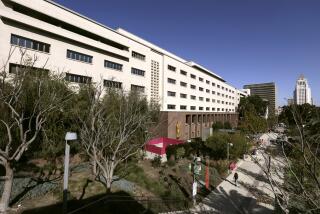Angelenos Given a Glimpse Deep Into City’s Past
- Share via
You might call it a monument to California’s spirit of reinvention--a building with nearly as many lives as a cat and more connections to Los Angeles’ civic culture than most politicians.
In its 75-year history, downtown’s Subway Terminal Building has housed the city’s first underground transit terminal, doubled as a World War II bomb shelter, provided hospital care to veterans, and acted as the local office of the Department of Social Security. And if that’s not enough, the 12-story landmark, which is a city block long, is playing host to a modern dance production and its current owners hope to convert it into a complex of apartments, offices and restaurants and a live performance theater.
Despite its colorful history though, few Angelenos have had the chance recently to investigate its most historic features: a once-grand ticketing concourse and a gaping, underground entryway to the city’s first and now-unused, mass-transit tunnel, a mile-long passage that was used by the Red Cars. Now, owners of the 417 S. Hill St. building have unbolted its darkened corridors for architecture enthusiasts and patrons of the Collage Dance Theater.
On Saturday, a team of Los Angeles Conservancy docents led several tours into the building’s lobby, which features marble columns, brass elevator doors and an imposing replica of a Rodin statue, “The Thinker.” From there the groups passed into the dimly lit ticketing concourse and then down a labyrinth of corridors and stairways to the main transit terminal--a tunnel wide enough and tall enough for two trains. Amid the rubble and musty odor, tour guests peered down the inky black tunnel with flashlights and portable lamps.
Among those eager visitors was Arthur Reynolds, a 67-year-old Wilshire district resident. While most were seeing the terminal for the first time, Reynolds said he knew it intimately from years past. Not only had he hopped onto Los Angeles’ Red Cars there as a boy, he had also visited the hospital in 1980, when he was treated for a stroke.
“My God, this brings back old memories,” Reynolds said. “I remember riding those electric cars the most. They were fast.”
Designed by Schultze and Weaver, the same architects who designed the Biltmore Hotel, the Subway Terminal Building has a floor plan nearly identical to the hotel’s. Hidden below the terminal building’s many retail and office spaces was the city’s primary hub for the Pacific Electric rail line. In its heyday, more than 800 trains a day traveled thorough the terminal’s mile-long tunnel and emerged near Glendale Boulevard and 1st Street, in the neighborhood of Belmont High School.
“It was meant to be the seed of a vast subterranean system,” said Richard Webber, a Los Angeles Conservancy docent. “Unfortunately, they didn’t get past that first mile.”
Up until this month, when the Collage Dance Theater group began staging its performance “Sub Versions” in the tunnel, the only activity there was the constant drone of a sump pump, which keeps the tunnel from flooding. “If this pump didn’t run constantly, we’d be swimming down here” said Jane McNamara, the conservancy’s director of education.
The building was purchased three years ago for $2.5 million by System Property Development Co., which hopes to renovate it with a mix of offices and apartments. Developers are still searching for a designer.
During Saturday’s tours, guests said they were dismayed to find that much of the ticketing concourse had been damaged by past office renovations. Among other things, former tenants had destroyed its coffered ceilings by adding dropped acoustical ceilings. Ornate terra cotta columns had been stripped, and the concourse’s formerly rich Tennessee pink marble floor was dulled and stained to the color of putty.
At the close of the tour, however, participants said their lasting memory of the old building would be the long-forgotten tunnel.
“I think it’s amazing,” said tour participant Kenneth Gant, 43, of Paramount. “It’s all still here and yet nobody knows about it. I think that’s unfortunate.”
More to Read
The biggest entertainment stories
Get our big stories about Hollywood, film, television, music, arts, culture and more right in your inbox as soon as they publish.
You may occasionally receive promotional content from the Los Angeles Times.











